Types of Cookware: What is Best for Me?
Trying to decide which is the best type of cookware for your needs? Read our guide and find out and then dive in deeper for some more knowledge. Read now.
If you love to cook or you’re looking forward to learning to prepare good at home, then buying high end cookware is probably the best place to start and reading as many cookware reviews as possible will get you more educated on what you are buying.
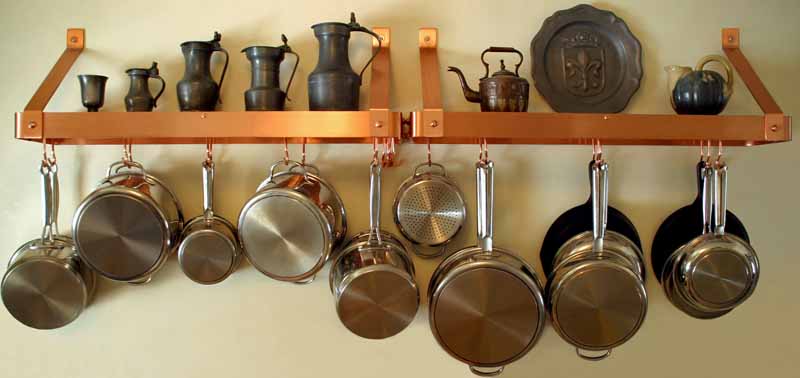
On the other hand, if you seldom cook or find it excruciating to be in the kitchen, spending a lot of money on items that will not be used seems silly. Let’s take a look at what’s out there.
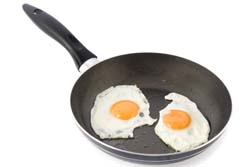 Most pots and pans fall under two categories, non-stick or uncoated. T-Fal, for example, falls under the non-stick category. The basic plus side of non-stick is obvious, food doesn’t stick to the pans making clean up a breeze. The downside is that most non-stick pans should not be used for high heating nor can you use metal utensils for stirring, scraping or flipping.
Most pots and pans fall under two categories, non-stick or uncoated. T-Fal, for example, falls under the non-stick category. The basic plus side of non-stick is obvious, food doesn’t stick to the pans making clean up a breeze. The downside is that most non-stick pans should not be used for high heating nor can you use metal utensils for stirring, scraping or flipping.
You’ll find most non-stick pans sport a plastic handle which gives the cookware another disadvantage; they cannot go from stove top to an oven beyond 350 degrees.
However, the handles don’t get hot while cooking and non-stick pans and skillets tend to be lighter overall.
As non-stick ages the Teflon coating begins to flake and ends up in food and ultimately ingested. As the jury decides the health risks and hazards of Teflon a good approach may be to look elsewhere or keep one or two pieces for eggs and omelets and other foods that have a tendency to be “clingy.”
Read non-stick cookware reviews now
Aluminum, stainless steel and cast iron all fit under the heading of uncoated. Each type of cookware has its pros and cons. The price range varies greatly depending on the gauge of the metal, where it is manufactured, and of course the reputation of the brand.
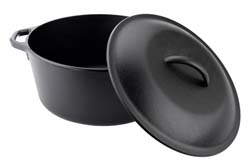 Some folks rave about cast iron and stand behind it as the best way to cook.
Some folks rave about cast iron and stand behind it as the best way to cook.
Cast iron may be slow to heat and cool, but conducts heat even and with consistency. This is a huge plus in the cookbook of most chefs. The durability of a well-kept cast iron is widely known; they can last forever.
Cleaning it up can be as simple as wiping it with a paper towel or soft cloth if the skillet has been seasoned correctly. At the other end of the spectrum lies a skillet that requires a lot of elbow grease and time to clean it properly.
Some people believe it’s a good idea to have at least one well-seasoned cast iron skillet waiting in the pantry.
Want to know more? Take a look at Foodal’s Cast Iron Reviews.
Carbon steel is very similar in performance and has seasoning requirements to cast iron.
This material is a bit lighter in weight but cooks much the same way as cast and is a suitable alternative for those who don’t want lug around a heavy skillet. Read more about carbon steel cookware now.
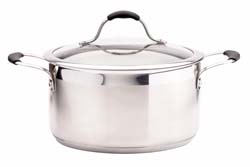 These are two of the most popular metals for pots and pans. This is the realm of companies such as Calphalon and All-Clad. Commercial level pots and pans are heavy and last, but along with the durability of the product comes a heftier feel and a high end price.
These are two of the most popular metals for pots and pans. This is the realm of companies such as Calphalon and All-Clad. Commercial level pots and pans are heavy and last, but along with the durability of the product comes a heftier feel and a high end price.
Many of the stainless steel varieties are clad or “tri-ply” – meaning that they sandwich a thick layer of aluminum and or copper in between two layers of stainless in order to take advantage of the thermal properties of these two metals.
Stainless steel and aluminum cookware are the most versatile.
Both are dishwasher safe and they hold up to metal utensils and are safe for acidic foods. When it comes to browning, aluminum and stainless steel beats most and ties with cast iron, depending on the cook’s preferences.
Read more reviews of stainless steel, raw aluminum, and clad cookware.
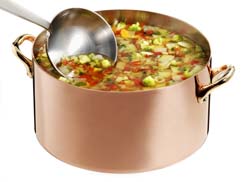 Although not as widely used today, Copper is still considered to be one of the best materials for cookware today thanks to its super conductivity of heat.
Although not as widely used today, Copper is still considered to be one of the best materials for cookware today thanks to its super conductivity of heat.
This heat spreads evenly throughout the pan’s bottom making and it is simple to dial in incremental adjustments to the temperature and is a favorite of French chefs (it is not a coincidence that the bulk of it is still made in France).
With the exception of a few sets purposely engineered for this purpose, most copper examples are not compatible with induction ranges. Check out Foodal’s copper cookware reviews now.
A good conductor of heat, tempered glass has the ability to go from freezer to oven to table without skipping a beat. An unfortunate disadvantage is that tempered glass breaks easily if dropped or banged.
As you can see, there are many types to choose from and Foodal offers many cookware reviews to help you decide.
For futher research check out Foodal’s Guide to the Best Cookware or all of the assorted articles and cookware reviews below.
Trying to decide which is the best type of cookware for your needs? Read our guide and find out and then dive in deeper for some more knowledge. Read now.
Easy to make with simple ingredients, comforting and hearty one-pot meals are considered to be the ultimate comfort food. But what kind of cookware do you need to make them? With versatile equipment like Dutch ovens and slow cookers, discover our five favorite options for this style of food preparation. Read more now.
We all know someone who absolutely hates to cook, for one reason or another. If you are determined to finally put them in an apron, here are a few smart gift ideas that might convince them the kitchen really isn’t so bad after all. From cooking appliances to reading materials, read more now for our best suggestions.
Are you wondering about the best way to clean and care for your saucepan to make it last as long as possible? Is a metal spoon fine to use in it when stirring, and is it safe in the dishwasher? We answer all of these questions and more in our guide to extending the life of your saucepan. Read more now.
A skillet’s a skillet – or is it? Do you know the difference between a saute pan and a fry pan? Read on for a comparison of these two types of stovetop cookware. Learn the similarities and differences and the best uses of each. You may be surprised. And next time a recipe calls for one or the other, you’ll be prepared.
Large and sturdy, a good-quality roaster is a versatile piece of cookware for daily use and for entertaining. They’re ideal for cooking large proteins, assorted veggies, and one-pan meals or stews as well. Read our guide to the best roasting pans to learn about all the features and materials, and choose your favorite.
For family dinners or entertaining a crowd, serving up a big dish of mixed seafood or steamed shellfish is always a favorite. And for the finest flavors, showiest presentation, and deluxe dining fun, you need the best kitchen equipment. Check out our top choices to find the best pot for cooking seafood and shellfish.
Do you dream of making the perfect paella? One that’s bold and colorful, with that iconic crispy rice crust? As long as you have a well-designed, high-quality pan in your kitchen, you’re on your way to delicious results. Made In’s Blue Carbon Steel Paella Pan may be the right choice for you. Read our full review now.
Ready to learn everything you need to know about paella pans? From the various kinds available to their unique attributes, which are the most popular, and why, you’ll find it all in our ultimate guide. This is a must-read before purchasing your first paella pan, or a new one to add to your collection. Read more now.
Want to purchase premium cooking equipment? If you’re a couple moving into your first home together, or a family in need of an upgrade, check out Made In Cookware. Featuring all the basic pots and pans you need, this company is dedicated to giving you the best kitchen essentials. Read our review now.
Looking to replace your cookware set with an upgrade? Getting ready to move and need a replacement set? Check out our guide and let us help you find the best for your home.
Cast Iron lost it’s luster when non-stick became the rage starting in the late 1960s. And now it has been rediscovered. Find out how to choose the best for your home. Take a look at bare “seasoned” cookware vs the French (and French inspired) porcelain pieces. Take a gander at the various types including: frying pans, dutch ovens, roasters, and more. Find out what’s worth buying now.
Confused about which All-Clad Cookware Collection that your should purchase for your kitchen or place on your bridal registry? Read Food’s Guide now.